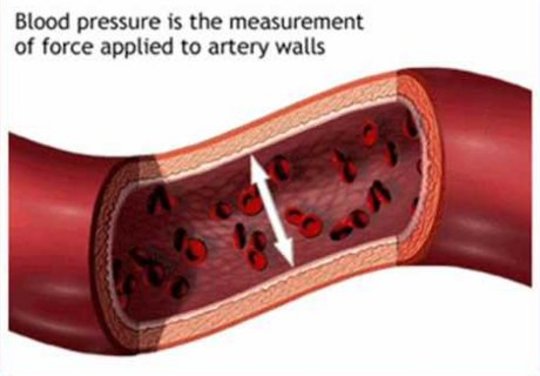
If you’re an adult and have ever visited a doctor, you’ve probably had your blood pressure measured. General practitioners tend to obsess over blood pressure. But with good reason: hypertension, or persistently high blood pressure, can lead to heart disease, stroke and diabetes, the nation’s biggest killers.
What Is Blood Pressure?
Blood pressure refers to how hard the blood is pushing against the wall of arteries – these can be thought of as the pipes that deliver blood from the heart (the blood “pump”) to the rest of the body.
This pressure is necessary for the blood to flow. Using a plumbing analogy, imagine the effect of a drop in water pressure to water flow from the garden hose.
Blood pressure naturally varies throughout the day depending on posture, activity and stress. It can also be elevated or lowered as a consequence of illness or disease.
Stephen Hales, an 18th-century English clergyman and scientist, first measured the blood pressure of animals in a series of experiments that involved inserting tubes into their arteries. In one experiment with a horse, he describes the blood rising to eight feet in height in the tube!
Blood pressure measurement would almost certainly be unpopular if it involved inserting long glass tubes into people. Happily, Italian physician Scipione Riva-Rocci developed the conventional sphygmomanometer, or blood pressure meter, in 1896.
Soon afterwards, Russian physician Nikolai Korotkoff discovered the sounds that can be heard with a stethoscope over the inner elbow while using a sphygmomanometer. His technique remains the standard method for measuring blood pressure today.
Interestingly, the conventional sphygmomanometer uses a column of liquid mercury to indicate the pressure. As mercury is so much denser than water or blood, even very elevated blood pressures result in it rising no more than about a foot.
This quirk of medical history gives us the modern measurement unit for blood pressure: millimetres of mercury (mmHg). A blood pressure measurement of 140 mmHg literally means that the pressure will push up a column of liquid mercury 14 centimetres.
Two numbers are given when reporting blood pressures, such as 140/90 mmHg. The first number is the systolic blood pressure. This is the pressure when the heart is contracting to pump its content of blood into the circulation.
The second number is the diastolic blood pressure. This is the pressure when the heart is relaxing and is refilling with blood.
What Is Normal?
The National Heart Foundation guidelines define “normal” blood pressure withing the following range:
-
Systolic blood pressure: 100 to 139 mmHg
-
Diastolic blood pressure: 60 to 89 mmHg.
These thresholds are arbitrary, but a blood pressure less than 140/90 mmHg is not labelled as high.
We’re also moving away from categorical descriptions of hypertension, based on blood pressure reading alone, towards a model where blood pressure is considered alongside other risk factors to determine whether drug or lifestyle interventions are needed.
Clinicians now calculate the patent’s absolute cardiovascular disease risk: the probability they will have a heart attack or stroke in the short and medium term, which includes age and cholesterol levels. This calculator can help you work out your absolute disease risk.
All adults should consider having their blood pressure measured at least once every two years. If it’s elevated, and confirmed, you’ll work with your GP to create a management plan to lower your blood pressure. This is likely to lifestyle changes such as:
- getting regular physical activity
- quitting smoking
- reducing the amount of salt you eat
- increasing the amount of potassium you consume (from foods such as parsley, dried apricots, some nuts, bamboo shoots, bananas, avocados, soybeans and bran)
- losing weight
- drinking less alcohol.
Keep in mind that visiting the doctor can provoke anxiety, so the blood pressure can be elevated in response to the testing procedure itself. This has been called the “white coat effect”.
If this is suspected, your GP might try recording your blood pressure over a number of visits, or use ambulatory or home blood pressure monitoring to get an accurate reading.
This article was originally published on The Conversation
Read the original article.
About the Author
 Michael Tam is a Staff Specialist in General Practice at the General Practice Unit in Fairfield Hospital, located in South Western Sydney. He is a Conjoint Senior Lecturer in the School of Public Health and Community Medicine at the University of New South Wales (UNSW) Australia.
Michael Tam is a Staff Specialist in General Practice at the General Practice Unit in Fairfield Hospital, located in South Western Sydney. He is a Conjoint Senior Lecturer in the School of Public Health and Community Medicine at the University of New South Wales (UNSW) Australia.
This article was co-authored by Dr Patrick Khoury, a GP registrar at the General Practice Unit, Fairfield Hospital, located in South Western Sydney.
Disclosure Statement: Michael Tam is a general practitioner and consults with patients who have hypertension. He otherwise does not work for, consult to, own shares in or receive funding from any company or organisation that would benefit from this article, and has no relevant affiliations.
Recommended book:
The Harvard Medical School Guide to Tai Chi: 12 Weeks to a Healthy Body, Strong Heart, and Sharp Mind -- by Peter Wayne.
 Cutting-edge research from Harvard Medical School supports the long-standing claims that Tai Chi has a beneficial impact on the health of the heart, bones, nerves and muscles, immune system, and the mind. Dr. Peter M. Wayne, a longtime Tai Chi teacher and a researcher at Harvard Medical School, developed and tested protocols similar to the simplified program he includes in this book, which is suited to people of all ages, and can be done in just a few minutes a day.
Cutting-edge research from Harvard Medical School supports the long-standing claims that Tai Chi has a beneficial impact on the health of the heart, bones, nerves and muscles, immune system, and the mind. Dr. Peter M. Wayne, a longtime Tai Chi teacher and a researcher at Harvard Medical School, developed and tested protocols similar to the simplified program he includes in this book, which is suited to people of all ages, and can be done in just a few minutes a day.
Click here for more info and/or to order this book on Amazon.

























